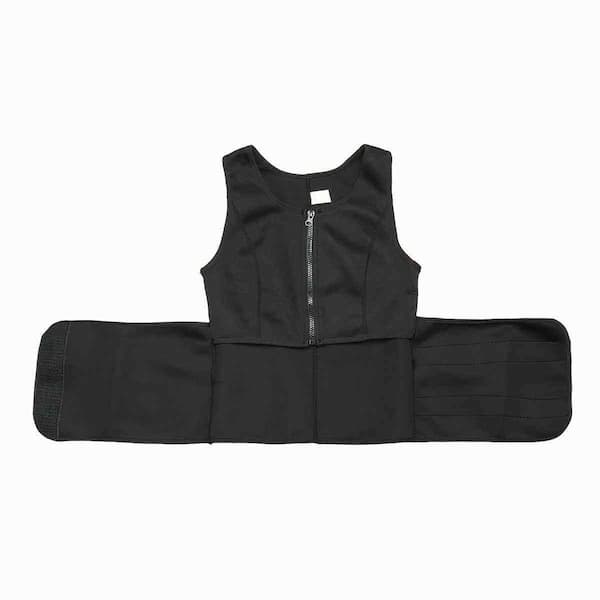When Can You Wear A Waist Trainer After Giving Birth? Do You Need It

When can you wear a waist trainer after giving birth? About 6 weeks.
After giving birth, you must give your body enough time so that your uterus can return to its pre-pregnancy size and clear out the fluid that accumulated during the pregnancy. Before beginning waist training, this process could take up to 6 weeks.
Please read on for more detailed information.
What Is A Waist Trainer?
A waist trainer works similarly to a vintage corset by drawing your waist in to give you Kim Kardashian’s hourglass figure.
Though it’s also suggested by sellers that you can wear it while exercising to intensify your workout (though you definitely shouldn’t have it on for torso-bending moves like crunches).
When Can You Wear A Waist Trainer After Giving Birth?
You need to give your body enough time after giving birth to reduce your uterus to its pre-pregnancy size and flush out the water retention. The process may take around 6 weeks before you can start waist training.
Lessening the strain on the ligaments and joints in the lower back, pelvis, and buttocks is made possible by waist trainers, which also provide support, draw out slack muscles, and help with posture. It will make the process of getting back to your pre-pregnancy shape much quicker. By pulling the muscles and skin closer together while wearing a binding garment, the abdominal muscles regain their original shape. This is also supported by medical professionals.
With the right exercise and a healthy diet, waist training is most effective. Avoid sugar and refined carbohydrates, drink plenty of water, and eat a healthy diet. As you attend to your child’s needs, you’ll feel more energised, and your body will undoubtedly thank you.
Starting out with a low-intensity exercise program, you should gradually introduce higher-intensity workouts that combine strength training and cardio exercises. The ideal scenario is for you to exercise almost every day.
Ways To Wear A Waist Trainer After Giving Birth
Here is what to anticipate in the postpartum period if you want to begin waist training to support your abdomen and back as you heal, though everyone is a little bit different in this regard.
Weeks 0–6
Once you have returned home from the hospital, you can begin wearing a garment, such as the First Stage Marena Suit with Suspenders and No Leg by Comfortwear FBA, that offers gentle compression and support for your abdomen. During your recovery, the compression of the garment aids in reducing swelling and promoting tissue healing.
As you spend time with your newborn, make sure to get plenty of rest, drink plenty of water, and eat plenty of healthy food. Wear your waist trainer as long as it is comfortable, but take it off if you’d rather unwind. You don’t have to wear it all the time.
Week 6
Start putting on your waist trainer more firmly and continuously. Wear a high compression waist trainer for no more than an hour or two at first per day, and as you get used to it, gradually increase the amount of time you spend wearing it.
The Second Stage Marena Support Girdle with No Legs by Comfortwear LGA2 is a fantastic outfit for this stage. This garment is a stage 2 compression item, meaning it has a little more compression and is sized a little bit smaller than a stage 1 item.
If your doctor approves, this is also the ideal time to begin a light exercise program. Establish a routine by going for a stroll while pushing a stroller. Your exercise time will be well spent, even if you only wear a waist trainer occasionally each day.
Week 12
You ought to have gotten used to your new routine by now. If you follow a daily waist training regimen, you should feel at ease wearing your waist trainer for at least 8 hours each day by this point. You can alternate between wearing a regular waist trainer while working or relaxing at home and a workout band while working out. With three rows of hooks and plenty of room to size down over the coming weeks and months, we suggest the Hourglass Angel HA102 Best Waist Trainer.
Keep in mind that recovering your body after pregnancy takes time. Hormones that relax your muscles and ligaments will be in your system for up to 6 months after the birth; what’s more, it took 9 months to stretch out your body to begin with!
A sensible diet, sufficient exercise, and waist training are the best combinations. While avoiding sugar and refined carbohydrates, put your attention on drinking lots of water and eating whole foods. Your body will thank you, and you’ll feel more energised as you attend to your child’s needs.
You should begin with a gentle exercise program because your muscles and ligaments will be more relaxed, but as time goes on, gradually add higher intensity workouts that combine strength training and cardio. Ideally, you should exercise nearly every day.
You can take care of yourself and take a break while working toward your fitness goals by joining a gym that offers childcare as a perk of membership. Alternately, you might try working out while your child is sleeping at home or while using a jogging stroller. When you don’t have time for a thorough workout, taking quick strolls or making an effort to move more can improve your health and body composition. These actions also release endorphins, which can improve your mood.).

When Trying To Get Pregnant, Should You Wear A Waist Trainer?
No, do not wear one if you are trying to conceive.
Even though the womb is still in the pelvis at that point, you are pregnant for a while before the test is positive, so it is best to stay away from anything constrictive around the abdomen.
These have the potential to cause health issues, which is important when trying to get pregnant because you want your body to be as healthy as it can be.
When Used After Childbirth, Do Waist Trainers Help?
Wearing waist trainers, which are compression bands, will help you define your midsection and give you an “hourglass figure.”
In an effort to reduce their waist sizes, many women wear it.
But do they really make a difference?
You won’t be able to lose weight or get your body shape back if you continue to wear a waist trainer after giving birth.
That doesn’t mean you can’t still use them, though.
It’s crucial to avoid using extremely tight waist trainers if you decide to use one, as these can do more harm than good.
Instead, in the first few weeks following delivery, I advise using an abdominal binder.
The material used to make abdominal binder is stretchy and can fit different body types.
Within the first few days after delivery, this kind of binder can help to support the core and make walking more comfortable.
Does Waist Training Flatten Your Stomach?
While waist training can temporarily give the appearance of a flat stomach, it does not actually aid in belly fat loss.
You will experience increased sweating in your abdomen while wearing one, but this does not aid in fat loss.
In fact, if you are not careful, waist training could be dangerous.
Here’s why.
Waist Training Negative Effects
While waist trainers might appear to be safe to use, there are a few things you need to remember.
Strongly constricted shoes, in particular, can lead to:
- Improper breathing mechanics,
- A weakened core,
- Poor digestion, and
- Musculoskeletal injuries
Let’s go over each of these points in more detail.
Impaired Diaphragmatic Breathing
You must be able to expand your belly completely in order to breathe properly.
This is known as diaphragmatic breathing,
Diaphragmatic breathing is actually among the best exercises you can do right away after giving birth to help your core and pelvic floor muscles recover.
However, if you are wearing a very tight waist trainer it can
- impair your ability to expand your abdomen,
- compress your rib cage,
- and not allow full expansion of your lungs
By doing this, you will be limiting how much air enters and leaves your body. This can lead to weakness, fatigue, and possibly fainting.
Core Weakness
Your abdominal muscles support your spine and keep your body upright as one of their many functions.
Your spine can be bent, twisted, and flexed in various ways thanks to your abdominal muscles.
Your core muscles are prevented from doing their part and participating in spinal movements by keeping them compressed.
Because of pregnancy, your core has already weakened. So it’s crucial to strengthen them during the postpartum period.
Poor Digestion
In addition to compressing your core muscles and your rib cage, your internal abdominal organs will also get compressed.
Contrary to popular belief, your small bowel requires room to move around as it pushes food particles through your digestive system.
Peristalsis is the physiological process causing this.
It is theoretically possible to impede digestion by compressing your abdomen and perhaps your intestines.
Musculoskeletal Injury
Last but not least, a tight corset can severely restrict the range of motion in your torso’s muscles.
As a result of your restricted mobility, you might find yourself in uncomfortable positions, which may lead to the compensatory use of other, secondary muscles.
Muscle overuse, pain, and injury can result from poor movement patterns over time.
You might still decide to give it a try after reading all of that.
If you decide to use one, it is important that you do not tighten it so much that it cinches your abdomen.
Additionally, I advise against using one right after delivery.
Conclusion
It takes time to get your body back to how it was before becoming pregnant. Be patient because it took your body 9 months to stretch out, to begin with, and hormones that relax your muscles and ligaments will remain in your system for up to 6 months after giving birth.
The article discussed when it is appropriate to use a waist trainer after giving birth. Hope this will help you.
I appreciate your reading. Finally, enjoy your day and your trip!